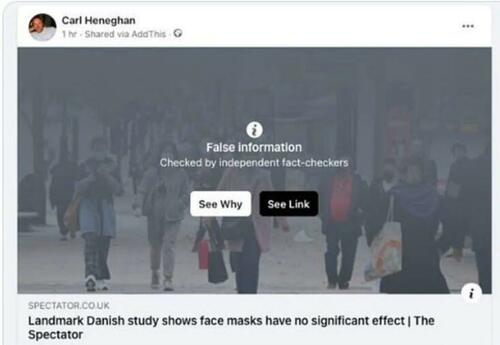
Authored by Dr. Carl Heneghan and Dr. Tom Jefferson via The Daily Sceptic,
At the centre of democracy is free speech. But everywhere you look it is under attack. There has been a surge in concerns about the creeping censorship that fills the airwaves and the increasing suppression on various media platforms.
Our work has been targeted by those who aim to silence and limit our right to free speech. Therefore, we consider it vital to understand the tactics of censorship to exercise your right to freedom of expression and contribute to the fight for free speech.
The Instant Emotional Outburst
This usually is an abusive attack that uses swear words (‘you stupid asshole‘) or seeks to defame you somehow: you’re a murderer, you have blood on your hands. It typically is an instantaneous reaction that seeks to shut down the debate immediately. Everyone should know you’re such a bad person, and therefore equally, your opinions are …..
We find this strategy impossible to engage with and should be ignored.
The Labelling Technique
This will pigeonhole you as an ‘anti’ something, a ‘phobic’ or an ‘-ist’. It may paint you as a Right-winger or a Left-winger. The aim is to put you in your place: you’re someone with a fixed ideology and, consequently, a terrible person. Therefore, your views aren’t worth engaging with. This is a common tactic as it doesn’t address the message you portray but instead attacks you, the messenger.
It’s a tactic that academics often use: Jeremy Farrar used it in his book. Somehow there are “serious scientists”, and therefore there are those that lack the ability to be serious.
As a strategy, it is impossible to deal with and is a certain ender of debate. However, when this happens, it generally means you are on the right track, so don’t be fazed by these disturbing actions; it shows the attacker has lost his way and cannot formulate a coherent argument; he has run out of options.
The Takedown
Increasingly this is the tactic of social media sites. Driven by certain positions that suit the status quo or the government of the day, you’ll be removed from social media sites such as Twitter or Facebook. Or your message will come with a warning.
Often underpinned by fact-checking sites, this strategy requires action to overcome any ban. We think it is necessary to regulate such sites if they act like news outlets. While the latter have editorial controls, the former should be clear about the process of what it should and shouldn’t allow and how it deals with disputes.
We also learned some politicians favour this tactic. For example, the Lockdown Files based on Leaked WhatsApp messages showed that attacks were partly orchestrated by Matt Hancock, who harnessed the full power of the state to silence ‘dissenters’. As far as Hancock was concerned, anyone who fundamentally disagreed with his approach was mad and dangerous and needed to be shut down.
One of the answers is to create multiple channels for your outlets, and increasingly, we’re finding Substack a valuable outlet for explainers about the problems.
The Undermining Publication.
While the emotional outburst, the labelling and the takedown undermine your credibility, a fourth approach is to produce a website or a publication that seeks to destroy your reputation.
In January 2021, a website called ‘Anti-Virus: The Covid-19 FAQ’ was created by a group unknown to us, including a sitting MP. Its sole purpose was to debunk messages that disagreed with mainstream Government policies — the website list “myths” about Covid and names “sceptics”, including us. If you click on names, you will be introduced to a series of capital charges against us. We were no longer evidence-based if we questioned the evidence for policies such as the Rule of Six.
The website was “dedicated to debunking common Covid Sceptic arguments and highlighting the track record of some of the most influential and consistently-wrong Covid Sceptics”.
However, the truth will emerge over the long term, and the proponents of such sites will end up wishing they had never embarked on such a foolhardy strategy.
But beware of being called out for making an error. Undertaking research is fraught with dangers; mistakes are common and can occur at all stages, even at the point of publication. An overzealous editor can change one word, and the whole meaning of your text can go out the window. Of course, mistakes made should be acknowledged and corrected. But beware of the censorship zealots who will seek to taint all your work going forward as error-strewn.
The complaints
An insidious approach that seeks to get your boss and your organisation to shut you up. The complainant hasn’t got the means or the argument to take you on directly. Instead, he or she goes behind your back, puts you and your family under pressure, and, in some circumstances, threatens your livelihood. In doing so, he accepts his inability to debate and discuss the issues directly.
However, sometimes they will also make a big deal over the investigation. Your work is tainted because the organisation deems you worthy of an investigation. The vast majority of complaints are disagreements, but organisations seem ill-equipped to tell the difference between a valid complaint and someone employing the tactics of censorship and suppression.
Editorial Bias
We have increasingly seen several journals and news outlets take a particular stance and only report or accept articles based on their ideological views. Unfortunately, nothing can be done to counter this problem; however, it is worth understanding those outlets that take such fixed views. Beware of those that seek to slander you editorially.
We’ve been surprised by some of the medical journals’ one-sided approaches – including the commissioning of biased and Teflon editorials and the deviation from usual editorial processes that seek to undermine the research output. Teflon is when the uncomfortable message cannot stick to you, the editor, because you are hiding behind an editorial undermining the research you do not like. In fact, with Teflon, nothing sticks.
Some editors cannot withstand the pressure of the social media posse, who circle their prey like vultures. The worst thing an editor can do is give in to these bullies: unelected, relentless and often overnight experts. Give in once to the posse, and you may perish, or even worse, you might find your work retracted. Be ready for the onslaught and prepare well. In your fightback, take the emotion out of your responses and turn to the evidence.
But beware of those editors who choose peer reviewers to support their one-sided views using anonymous attacks to suppress research outputs that don’t meet their predetermined opinions. Ultimately though, it will be to their discredit as they should be built on impartiality and fairness: it’s fair to say that journals have had a lousy pandemic. However, there’s little to do here but move on to the next journal; there’s plenty of them.
Comments Cartel
This is a brilliant tactic. It consists of an organised onslaught on a piece of published research work. You can see this in the comments to A122. The underlying message is that the research is unsound because so many people post negative comments; hence, science is democratic, and the Noes have it, which is nonsense. We recommend databasing the addresses of the senders if they exist and checking the text for style patterns, as most of the comments are repetitions passed along from one member of the cartel to the next.
It’s worth reminding yourself of some laws that protect you if you decide to speak out.
The 1986 Education Act (No.2) states: “Persons concerned in the Government of any establishment… shall take such steps as are reasonably practicable to ensure that freedom of speech within the law is secured for members, students and employees of the establishment and for visiting speakers.” The 1988 Education Reform Act references the right of U.K. academics “to question and test received wisdom and to put forward new ideas and controversial or unpopular opinions without placing themselves in jeopardy of losing their jobs or the privileges they may have at their institution”. The European Convention on Human Rights Article 10 states that “protection extends to the expression of views that may shock, disturb or offend the deeply held beliefs of others”. UNESCO’s 1997 Recommendation concerning the Status of Higher-Education Teaching Personnel states that institutions should be accountable for effectively supporting academic freedom and fundamental human rights.
It comes down to this: no single idea or belief should be privileged. Everyone has the right to freedom of expression. If we elicit an emotional response or find that folk disagree or are disappointed by our answers, we have done our job. However, emotions that lead to the tactics of suppression and censorship fail to engage critically with the issues of the day.
Reflecting uncertainty is a central tenet of free speech. However, the current pursuit of truth is a path filled with hazards. Learning to approach matters of debate critically and with confidence will ensure our democratic values remain intact.
* * *
Dr. Carl Heneghan is the Oxford Professor of Evidence Based Medicine and Dr. Tom Jefferson is an epidemiologist based in Rome who works with Professor Heneghan on the Cochrane Collaboration. This article was first published on their Substack blog, Trust The Evidence, which you can subscribe to here.
Authored by Dr. Carl Heneghan and Dr. Tom Jefferson via The Daily Sceptic,
At the centre of democracy is free speech. But everywhere you look it is under attack. There has been a surge in concerns about the creeping censorship that fills the airwaves and the increasing suppression on various media platforms.
Our work has been targeted by those who aim to silence and limit our right to free speech. Therefore, we consider it vital to understand the tactics of censorship to exercise your right to freedom of expression and contribute to the fight for free speech.
The Instant Emotional Outburst
This usually is an abusive attack that uses swear words (‘you stupid asshole‘) or seeks to defame you somehow: you’re a murderer, you have blood on your hands. It typically is an instantaneous reaction that seeks to shut down the debate immediately. Everyone should know you’re such a bad person, and therefore equally, your opinions are …..
We find this strategy impossible to engage with and should be ignored.
The Labelling Technique
This will pigeonhole you as an ‘anti’ something, a ‘phobic’ or an ‘-ist’. It may paint you as a Right-winger or a Left-winger. The aim is to put you in your place: you’re someone with a fixed ideology and, consequently, a terrible person. Therefore, your views aren’t worth engaging with. This is a common tactic as it doesn’t address the message you portray but instead attacks you, the messenger.
It’s a tactic that academics often use: Jeremy Farrar used it in his book. Somehow there are “serious scientists”, and therefore there are those that lack the ability to be serious.
As a strategy, it is impossible to deal with and is a certain ender of debate. However, when this happens, it generally means you are on the right track, so don’t be fazed by these disturbing actions; it shows the attacker has lost his way and cannot formulate a coherent argument; he has run out of options.
The Takedown
Increasingly this is the tactic of social media sites. Driven by certain positions that suit the status quo or the government of the day, you’ll be removed from social media sites such as Twitter or Facebook. Or your message will come with a warning.
Often underpinned by fact-checking sites, this strategy requires action to overcome any ban. We think it is necessary to regulate such sites if they act like news outlets. While the latter have editorial controls, the former should be clear about the process of what it should and shouldn’t allow and how it deals with disputes.
We also learned some politicians favour this tactic. For example, the Lockdown Files based on Leaked WhatsApp messages showed that attacks were partly orchestrated by Matt Hancock, who harnessed the full power of the state to silence ‘dissenters’. As far as Hancock was concerned, anyone who fundamentally disagreed with his approach was mad and dangerous and needed to be shut down.
One of the answers is to create multiple channels for your outlets, and increasingly, we’re finding Substack a valuable outlet for explainers about the problems.
The Undermining Publication.
While the emotional outburst, the labelling and the takedown undermine your credibility, a fourth approach is to produce a website or a publication that seeks to destroy your reputation.
In January 2021, a website called ‘Anti-Virus: The Covid-19 FAQ’ was created by a group unknown to us, including a sitting MP. Its sole purpose was to debunk messages that disagreed with mainstream Government policies — the website list “myths” about Covid and names “sceptics”, including us. If you click on names, you will be introduced to a series of capital charges against us. We were no longer evidence-based if we questioned the evidence for policies such as the Rule of Six.
The website was “dedicated to debunking common Covid Sceptic arguments and highlighting the track record of some of the most influential and consistently-wrong Covid Sceptics”.
However, the truth will emerge over the long term, and the proponents of such sites will end up wishing they had never embarked on such a foolhardy strategy.
But beware of being called out for making an error. Undertaking research is fraught with dangers; mistakes are common and can occur at all stages, even at the point of publication. An overzealous editor can change one word, and the whole meaning of your text can go out the window. Of course, mistakes made should be acknowledged and corrected. But beware of the censorship zealots who will seek to taint all your work going forward as error-strewn.
The complaints
An insidious approach that seeks to get your boss and your organisation to shut you up. The complainant hasn’t got the means or the argument to take you on directly. Instead, he or she goes behind your back, puts you and your family under pressure, and, in some circumstances, threatens your livelihood. In doing so, he accepts his inability to debate and discuss the issues directly.
However, sometimes they will also make a big deal over the investigation. Your work is tainted because the organisation deems you worthy of an investigation. The vast majority of complaints are disagreements, but organisations seem ill-equipped to tell the difference between a valid complaint and someone employing the tactics of censorship and suppression.
Editorial Bias
We have increasingly seen several journals and news outlets take a particular stance and only report or accept articles based on their ideological views. Unfortunately, nothing can be done to counter this problem; however, it is worth understanding those outlets that take such fixed views. Beware of those that seek to slander you editorially.
We’ve been surprised by some of the medical journals’ one-sided approaches – including the commissioning of biased and Teflon editorials and the deviation from usual editorial processes that seek to undermine the research output. Teflon is when the uncomfortable message cannot stick to you, the editor, because you are hiding behind an editorial undermining the research you do not like. In fact, with Teflon, nothing sticks.
Some editors cannot withstand the pressure of the social media posse, who circle their prey like vultures. The worst thing an editor can do is give in to these bullies: unelected, relentless and often overnight experts. Give in once to the posse, and you may perish, or even worse, you might find your work retracted. Be ready for the onslaught and prepare well. In your fightback, take the emotion out of your responses and turn to the evidence.
But beware of those editors who choose peer reviewers to support their one-sided views using anonymous attacks to suppress research outputs that don’t meet their predetermined opinions. Ultimately though, it will be to their discredit as they should be built on impartiality and fairness: it’s fair to say that journals have had a lousy pandemic. However, there’s little to do here but move on to the next journal; there’s plenty of them.
Comments Cartel
This is a brilliant tactic. It consists of an organised onslaught on a piece of published research work. You can see this in the comments to A122. The underlying message is that the research is unsound because so many people post negative comments; hence, science is democratic, and the Noes have it, which is nonsense. We recommend databasing the addresses of the senders if they exist and checking the text for style patterns, as most of the comments are repetitions passed along from one member of the cartel to the next.
It’s worth reminding yourself of some laws that protect you if you decide to speak out.
The 1986 Education Act (No.2) states: “Persons concerned in the Government of any establishment… shall take such steps as are reasonably practicable to ensure that freedom of speech within the law is secured for members, students and employees of the establishment and for visiting speakers.” The 1988 Education Reform Act references the right of U.K. academics “to question and test received wisdom and to put forward new ideas and controversial or unpopular opinions without placing themselves in jeopardy of losing their jobs or the privileges they may have at their institution”. The European Convention on Human Rights Article 10 states that “protection extends to the expression of views that may shock, disturb or offend the deeply held beliefs of others”. UNESCO’s 1997 Recommendation concerning the Status of Higher-Education Teaching Personnel states that institutions should be accountable for effectively supporting academic freedom and fundamental human rights.
It comes down to this: no single idea or belief should be privileged. Everyone has the right to freedom of expression. If we elicit an emotional response or find that folk disagree or are disappointed by our answers, we have done our job. However, emotions that lead to the tactics of suppression and censorship fail to engage critically with the issues of the day.
Reflecting uncertainty is a central tenet of free speech. However, the current pursuit of truth is a path filled with hazards. Learning to approach matters of debate critically and with confidence will ensure our democratic values remain intact.
* * *
Dr. Carl Heneghan is the Oxford Professor of Evidence Based Medicine and Dr. Tom Jefferson is an epidemiologist based in Rome who works with Professor Heneghan on the Cochrane Collaboration. This article was first published on their Substack blog, Trust The Evidence, which you can subscribe to here.
Loading…







